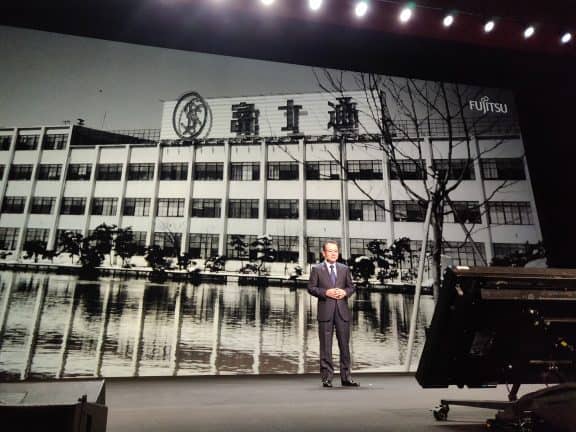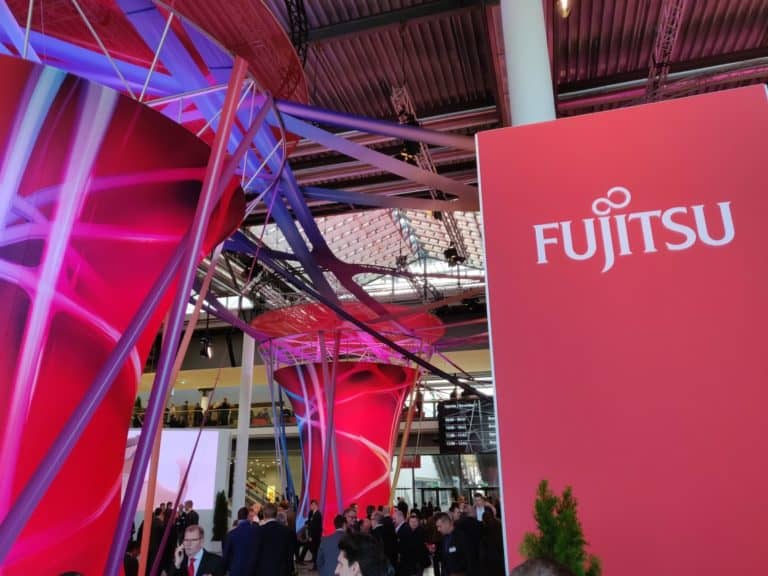In recent years, Fujitsu has been repositioning itself in the changing IT landscape. In doing so, it can partly build on the strong roots it already has after years, but new steps also need to be taken. One principle is central to this transition in any case: solving social problems. This will be done by means of co-creation. During our visit to the Fujitsu Forum in Munich, we wanted to clarify how the two principles go together within the new direction. It becomes clear that the company is taking nice steps, but that this also involves painful decisions.
What certainly graces the company is that it is so honest to acknowledge that it has an unchanged strategy compared to a year ago. As a result, Fujitsu is still in the midst of its transition to becoming a service-oriented company. Such a change logically requires the introduction of new services, but it also involves moving away from a number of common issues. This is typical for progress that is part of an established strategy course. The ultimate goal is to convert the decline in turnover, which we are currently seeing, into growth.
Painful decision immediately visible
This course of action has already led to major interventions. Just before the start of the conference, the company announced the closure of its factory in Augsburg, something that overshadowed the Fujitsu Forum. Employees and trade unions used the event to protest against the “necessary” decision that Fujitsu is presenting. The factory mainly made laptops and computers and employed about 1500 people. In all probability, they will find themselves out of work, even if they are looking at whether certain personnel can get a new job within the service branch.
However, the employees do not seem to be interested in this. They put their finger on the sore spot by pointing out the social message that we hear about the company so often, but that the social face in this matter is far away.
Within the doors of the Fujitsu Forum, the company was able to defend this decision very well. From now on, the production of the equipment will only take place in Japan, which is part of the decision to consolidate more and more activities. As sales of laptops and PCs are currently not at a peak, and Fujitsu is shifting its focus, we understand this business decision. Lenovo also previously acquired a majority stake in Fujitsu’s PC division, resulting in a joint venture. As a result, Lenovo will take over part of the business in this area. This combination of factors makes the closure a step in the right direction. Nevertheless, the decision symbolizes the shadow that stuck to the Fujitsu Forum.
Alignment with strategy
Fujitsu, however, has to move forward, and, therefore, the company chooses to abandon certain activities so that business technology is really prioritized. As mentioned before, the company also realizes this with existing and new solutions. Fujitsu is aware, for example, that many enterprise organizations are currently concerned with the cloud. This is anticipated by working with specialist parties. Amazon Web Services, VMware and Microsoft Azure, for example, are partners of Fujitsu.
Fujitsu took advantage of the conference to showcase new possibilities within collaborations, including those with Microsoft. By having Microsoft on board as a partner, Fujitsu can now bring its Primeflex series to Azure Stack. Primeflex is a Fujitsu solution that supports multiple environments, including SAP and Oracle. With Primeflex, Fujitsu wants to eliminate the complexity of deploying in supported environments, by taking a number of things off your hands. In the case of Azure Stack, this results in arranging matters relating to connectivity, storage, servers and software. In this way, Fujitsu can supply its own products, such as x86 servers and switches. In this respect, Primeflex is an excellent example of how Fujitsu can sell its IT products: it handles complex matters that enterprise IT organizations do not arrange themselves.

Centers of Excellence represent a course of action
Such targeted solutions show that Fujitsu’s ideas about going its own way within the IT landscape are fine. We are told several times that the so-called “Centers of Excellence” are the crucial part of the success of the chosen path. We should see these locations as the brain of Fujitsu that realizes the theme of “co-creation for success”. The Centers of Excellence specialize in a specific technology, such as artificial intelligence or blockchain. Four missions are then attached to the technology.
The missions can include the ambition to take a leading position within the specialization, but also the development of an ecosystem around the technologies. The latter requires several parties on board, including universities and their own customers. This is a typical means of keeping the knowledge up to date. In this respect, the ecosystem forms the basis of another aim of the Centers of Excellence, namely the transfer of expertise to ensure that all countries within the EMEA region benefit equally from the knowledge.
Ultimately, we believe that the most important objectives are to introduce solutions to address the customer’s business challenges. Fujitsu uses an example to explain exactly how it works. One of its customers was faced with declining revenues. This situation required more control over the financials. In this case, Fujitsu opted to apply robotic process automation (RPA) to certain business processes, including invoicing. According to Fujitsu, this process optimization led to cost savings of tens of percents. This is considerable, but given the increasingly positive stories we hear from RPA, it is not unrealistic.
Recognition is there, position is instable
When we hear Fujitsu talking about things like that, it tries to paint a pretty rosy picture of itself. Partly, they are right. After all, the company can build on years of experience in the IT world, which has now resulted in a foundation of which Primeflex and the Centers of Excellence form a part. Certain partners also see this as a strong foundation. For example, Fujitsu has been named Global OEM Alliance Partner of the Year by VMware, a party it has been working with for more than ten years. It is one of several things that shows that IT parties trust Fujitsu.
However, reality also teaches us that Fujitsu is struggling to remain a trusted partner within the IT landscape. The company has been struggling financially for some time now. For example, in the first half of the financial year, revenue fell by more than four percent. From the management level, there is great awareness of what the company really wants to do about it. The closure of the German factory is an example of this: activities will be more consolidated.
Fujitsu also wants to bring about change by cutting back the workforce. Certain positions and locations will be lost as a result. When we ask Fujitsu staff what the decisions mean to them, they all say that they will not be affected by them. Maybe they also hope for a new role within Fujitsu, as they are looking for new people for certain specializations. Think of cybersecurity experts, something the market is not exactly flooded by. Perhaps it would be an idea for Fujitsu to have a look at their own people?
Although there is this idea to tackle Fujitsu’s shaky position, the way in which it presents it is not perfect. For example, Fujitsu is talking about growth in 2022, while dissatisfied people are protesting outside in the square. And from visitors of previous Fujitsu Forum editions, we also understand that the show is a little less impressive than the year before. Last year, the exhibition floor was apparently filled with impressive robots, now we have to make do with staring at small screens for product demonstrations. We understand that this is part of the step back, but then it would be better if Fujitsu didn’t blow its own trumpet and really lets solutions speak for themselves.
Ultimately, the choices made are defensible. After all, a new path requires tough measures. For Fujitsu, it is to be hoped that it will also help to maintain its position in the IT landscape. After all, the company certainly has a good foundation, but it also has to translate this into growth.
